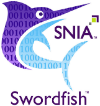Exclusive Interview With Three SNIA Leaders
Swordfish, new flagship effort from association
By Philippe Nicolas | October 2, 2017 at 2:27 pm
Michael Oros
He is:
- SNIA Executive director
He was:
- President at Romanian American Society
- VP APS
- Business development at Intel

Richelle Ahlvers
She is:
- Principal storage management software architect at Broadcom
- SNIA scalable storage management technical work group chair
She was:
- Principal consultant at RJ&D Consulting Services
- Storage management architect at HPE
- SNIA provisional SSM technical work group co-chair and chair, technical council; member board of directors
![]()
Don Deel
He is:
- Senior standards technologist at NetApp
- SNIA SMI governing board member and chairman, SMI technical work group chair, scalable storage management technical work group co-chair
He was:
- Senior technologist at EMC
- VP, CTO and founder at Prisa Networks
- SNIA technical council member and chairman
- and before that at AMCC, Scientific Computer Systems, Burroughs Corp. among others
 StorageNewsletter: Could you remind us the mission of the Storage Networking Industry Association? How has it evolved since its inception in 1997?
StorageNewsletter: Could you remind us the mission of the Storage Networking Industry Association? How has it evolved since its inception in 1997?
Michael Oros: SNIA’s mission is to lead the storage industry worldwide in developing and promoting vendor-neutral architectures, standards and educational services that facilitate the efficient management, movement and security of information. While the organization started with a focus on networked storage standards, interoperability and education, it has evolved to serve the members’ and industry’s needs over the past 20 years as new developments such as cloud, containers, NVMe, open-source, and many other technology disruptions have entered the global market. We continue to reinvent ourselves as an organization, innovate and drive technology advancements in areas that are of importance and relevance to our members, the greater development community and the worldwide users of these storage technologies.
What is the impact of SNIA on the storage industry especially since it celebrated its 20th anniversary this year? What have been some of the association’s main achievements during this period?
Oros: The number of storage standards SNIA has developed are numerous and cover a wide area of storage technologies – an extensive list is available on our website. These standards have a lifecycle from development, to early adoption, to mainstream, and eventually to end-of-life. The standards themselves have a profound impact on developers first and then work their way through the supply chain to vendors building technologies and services on top of these standards/products, ultimately reaching consumers of the technology. The minute you have multiple vendors developing solutions from the same standard, product interoperability and conformance to the specifications become critical aspects for deployment ramp and market adoption. Throughout this lifecycle, education and awareness is another key component for success of new technologies. SNIA has a comprehensive approach to educating developers and the industry at large – from conferences, to tutorials, webcasts and even certification programs for storage professionals. To give perspective on the footprint of the organization, SNIA has certified over 10,000 storage professionals globally, has more than 160-member companies, 2,500 active contributors and 50,000 IT and storage professionals worldwide.
What are the benefits for a vendor to join SNIA? And for end-users?
Oros: For a vendor, joining SNIA means the opportunity to take a leadership role and get early access to new technologies and industry intellectual property (IP). There are many facets to leadership – it could be in the technical work for a new technology standard, bringing it forward to become an industry standard, or driving education/awareness programs that create or grow a given technology market. The thought leadership capabilities of a company can impact revenue for their respective products/services. In terms of getting early access to storage standards that are in development and not yet public, vendors that are SNIA members have the opportunity to contribute to specifications, steer the direction and priorities of the development to serve their company’s needs, and ensure any products that are in development are in line with the emerging specification. In other words, you get to be in the kitchen participating in the meal creation and all the associated decisions, rather than being in position to just eat the meal that’s put in front of you at the table when it’s all done. To companies that are late-adopters of technology or have a ‘follower’ strategy, it may be perfectly acceptable to wait for the final specification. But what if you’re allergic to peanuts or can’t stand broccoli? SNIA gives you an opportunity to have your voice heard.
Also, there is the IP. Members and participants in the technical work, get access to industry IP via RAND (reasonable and non-discriminatory) licensing terms that are built into SNIA membership and IP agreements of the organization. This alone can be justification for a company joining SNIA.
In terms of end-users, the reasons and benefits of joining SNIA can be the same, particularly for some of the industries that operate large data centers/installations. For relatively smaller end-users, the ability to influence large vendors and suppliers to include features and capabilities that are essential for their business, is a great opportunity and value. This is especially evident when looking at how some of the new technologies (i.e. Persistent Memory) are having a much greater and direct impact on the way end-users develop internal applications and interact with hardware. End-users benefit from the access they receive to the leading community of storage experts. The ability to interact with all the decision makers and developers and bounce ideas off them, while also helping to solve problems, learn, teach and impact the future of our industry is invaluable.
Since storage standards and specifications is a key activity for SNIA, which ones would you say are the most known or widely adopted? Can you provide examples of products that integrate such standard developments and efforts?
Oros: You can find the current list of SNIA standards and you will see that they touch everything storage, from cloud, to tape, management, power efficiency, hardware, connectors and form-factors, performance and security. I can’t think of a single large storage vendor that does not implement SMI-S for their storage management – an example o a mature SNIA standard that is widely adopted by the entire industry. The SNIA Emerald program has wide industry participation for power efficiency, and deep engagements with the EPA and the respective global reach/partners. The SNIA Persistent Memory standard is a relatively newer and still evolving standard that has had great influence on how we think about compute and storage architecture. It will have profound impact on all systems and software in the near future. The tidal wave and subsequent ripple effects of this are imminent and will be far reaching.
Storage Management remains a complex task. SNIA launched Swordfish in September, 2016. Could you compare it to the SNIA SMI-S standard and other initiatives?
Richelle Ahlvers: When we listened to storage customers and vendors, it was clear they wanted improvements in storage management APIs to make storage simpler to implement and consume. The existing storage management standards have been implemented from a very vendor-centric perspective. Another area in need of improvement was access efficiency, such as improving functionality with fewer transactions containing more information in each one.
Customers and vendors also asked us to look at modernizing our interface in ways such as providing useful access on standard browsers, expanding coverage to new storage markets (such as converged, hyperconverged and hyperscale), and providing flexibility to an expanded set of storage management users (such as providing compatibility with standard DevOps tools and environments).
How was SNIA Swordfish developed? Was there a collaboration with the DMTF (Distributed Management Task Force)?
Ahlvers: To develop SNIA Swordfish, we didn’t want to start from scratch. We looked at what we wanted to do and pulled from two primary areas. First, we looked at content that had been developed as enhancements to the SNIA SMI-S primary storage management standard and leveraged the schema to create a simplified client-oriented model. Second, we looked at the DMTF Redfish specification that was built using RESTful technologies. Redfish uses the JSON format based on OData V4 and provides all of the base protocols and many of the core components for storage management. Swordfish is implemented as an extension of the Redfish API.
Who is developing the Swordfish specification? Are you beginning to see initial implementations?
Don Deel: Over 20 companies have helped develop Swordfish with some of the largest players in the industry taking a leading role including Broadcom, Dell EMC, HPE, Intel, Microsoft, NetApp and VMware. RESTful is a very well-known technology, and as developers start to do proof-of-concept and initial implementations, they are able to complete them very rapidly. We’ve certainly seen that play out in the initial Swordfish implementations. Redfish and Swordfish are also standards that can be implemented in a very small footprint. As an example, a lot of the initial Redfish implementations have been in baseboard management controllers.
As a user, what are the advantages to selecting a product that includes SNIA Swordfish? How could users verify and check if a vendor integrates the SNIA Swordfish standard?
Ahlvers: We designed the Swordfish interface to focus on the use cases the client wants. Since it gives them the same interface on every product, they don’t have to redefine their tools and customize them for every product they talk to. Part of the importance of Swordfish is that you have a single protocol that can be used for both server and storage management. For example, if a developer is using Python scripts, they can have the same login and script format for their servers and storage in a heterogenous environment. This allows them to pick best-in-class devices for their data center.
To ensure vendors integrate Swordfish into their solutions, users need to specify support for the standard in their RFQs.
What are the challenges for adoption of Swordfish?
Deel: The challenges that Swordfish faces is to ensure the functionally matches the needs of both the clients and the vendors while keeping the scope manageable.
Vendors see a clear value to providing a standard storage management approach and know they are going to save a lot of money by minimizing the number of APIs they have to support. If they can reliably settle on a standard API as opposed to dealing with a proliferation of API for servers and storage, it reduces the cost of equipment, IT training, in-house engineering and helps them develop new solutions faster.
On the client side, they’ve only got one protocol to worry about as a common tool set so it reduces cost on the consumer side also. Swordfish is client oriented so it’s made to satisfy the actual use cases.
What are the next steps in the development cycle for SNIA Swordfish?
Ahlvers: We are now focused on driving implementations while exploring what additional functionally is required to ensure those implementations are complete. We are also working to make sure the set of use cases that the Swordfish specification delivers match the needs of the end user.















 Subscribe to our free daily newsletter
Subscribe to our free daily newsletter

